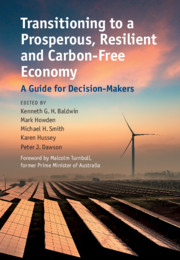Book contents
- Transitioning to a Prosperous, Resilient and Carbon-Free Economy
- Transitioning to a Prosperous, Resilient and Carbon-Free Economy
- Copyright page
- Dedication
- Contents
- Figures
- Tables
- Contributors
- Foreword
- Introduction
- 1 Policy Frameworks and Institutions for Decarbonisation: The Energy Sector as ‘Litmus Test’
- Technologies for Decarbonising the Electricity Sector
- Example Economies
- Cities and Industry
- Land Use, Forests and Agriculture
- 17 Land Use
- 18 Forests
- 19 Agriculture
- Mining, Metals, Oil and Gas
- Addressing Barriers io Change
- Index
- References
18 - Forests
from Land Use, Forests and Agriculture
Published online by Cambridge University Press: 08 October 2021
- Transitioning to a Prosperous, Resilient and Carbon-Free Economy
- Transitioning to a Prosperous, Resilient and Carbon-Free Economy
- Copyright page
- Dedication
- Contents
- Figures
- Tables
- Contributors
- Foreword
- Introduction
- 1 Policy Frameworks and Institutions for Decarbonisation: The Energy Sector as ‘Litmus Test’
- Technologies for Decarbonising the Electricity Sector
- Example Economies
- Cities and Industry
- Land Use, Forests and Agriculture
- 17 Land Use
- 18 Forests
- 19 Agriculture
- Mining, Metals, Oil and Gas
- Addressing Barriers io Change
- Index
- References
Summary
Human activities in forests contribute more than one-fifth of global greenhouse gas emissions. Forests face serious risks from climate change due to more intense and frequent mega-fires, drought and loss of ecosystem resilience resulting from biodiversity loss, which in turn impact the provision of ecosystem services. Priorities for mitigation of, and adaptation to, climate change are: avoiding emissions by protecting carbon stocks in natural ecosystems; sequestering carbon through restoration of degraded ecosystems; and reducing emissions through transferring wood production to plantations on existing cleared land, improving efficiency of wood processing, reducing waste, producing higher value wood products with longer lifetimes, substituting emissions-intensive building materials with wood, and recycling. Many co-benefits arise from forest management strategies for mitigation through protection and restoration. Effective governance and policy are critical to supporting and incentivising these mitigation and adaptation strategies to invest in restoration of native forests and development of plantation forests. Alternative policy development frameworks are discussed.
Keywords
- Type
- Chapter
- Information
- Transitioning to a Prosperous, Resilient and Carbon-Free EconomyA Guide for Decision-Makers, pp. 462 - 500Publisher: Cambridge University PressPrint publication year: 2021



